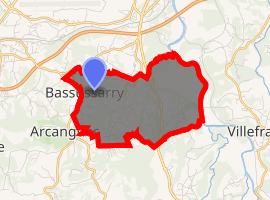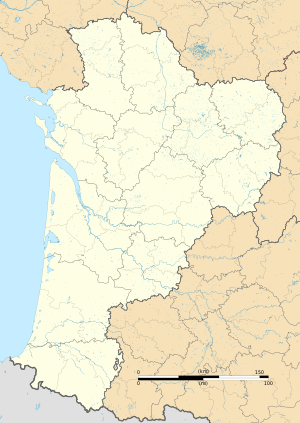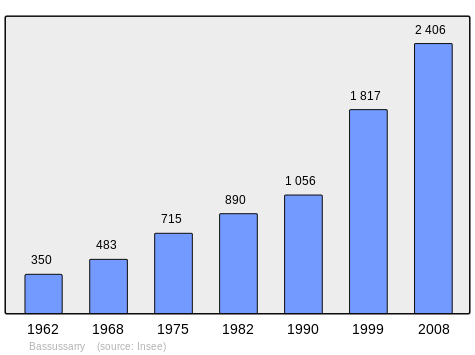Bassussarry
Bassussarry (Basque: Basusarri) is a commune in the Pyrénées-Atlantiques department in the Nouvelle-Aquitaine region of southwestern France.[2]
Bassussarry Basusarri | |
|---|---|
Town hall | |
.svg.png) Coat of arms | |
Location of Bassussarry 
| |
 Bassussarry  Bassussarry | |
| Coordinates: 43°26′50″N 1°30′38″W | |
| Country | France |
| Region | Nouvelle-Aquitaine |
| Department | Pyrénées-Atlantiques |
| Arrondissement | Bayonne |
| Canton | Ustaritz-Vallées de Nive et Nivelle |
| Intercommunality | CA Pays Basque |
| Government | |
| • Mayor (2014–2020) | Paul Baudry |
| Area 1 | 7 km2 (3 sq mi) |
| Population (2017-01-01)[1] | 3,126 |
| • Density | 450/km2 (1,200/sq mi) |
| Time zone | UTC+01:00 (CET) |
| • Summer (DST) | UTC+02:00 (CEST) |
| INSEE/Postal code | 64100 /64200 |
| Elevation | 2–85 m (6.6–278.9 ft) (avg. 8 m or 26 ft) |
| 1 French Land Register data, which excludes lakes, ponds, glaciers > 1 km2 (0.386 sq mi or 247 acres) and river estuaries. | |
The inhabitants of the commune are known as Basusartars.[3]
Geography
Bassussary is located in the former province of Labourd and within the urban area of Bayonne some 5 km south-east of Biarritz and 4 km south by south-west of Bayonne. Access to the commune is by the D932 road from Anglet in the north which passes through the commune on the eastern side and continues south to Ustaritz. The town is in the west of the commune and can be accessed by the D254 road which branches from the D932 on the northern border of the commune and continues through the town west to join the D810 south-west of Biarritz Airport. The D3 comes from the A63 autoroute Exit ![]()
Two bus services pass through and have stops in the commune operated by Transports 64:
- Service 860 Bayonne to Cambo-les-Bains
- Service 880 Bayonne to Arbonne
The commune lies in the drainage basin of the Adour with the Nive river forming the whole eastern border of the commune as it flows north to join the Adour. The Ruisseau d'Urdains flows from a small lake just south of the commune northwards, forming the north-eastern border of the commune, before joining the Nive in the north-eastern corner. The Ruisseau de Harrieta flows from the south-west of the commune to the north-east joining the Ruisseau d'Urbaine near the D932. The Ruisseau de Pétaboure rises in the north-west of the commune and forms the northern border as it flows east to join the Ruisseau de Harrieta in the commune.[4][5]
Toponymy
The commune name in Basque is Basusarri.[7] Jean-Baptiste Orpustan proposed a structure of baso meaning "forest" and sarri meaning "dense" or "tight" giving the overall meaning of "dense forest".[8]
The following table details the origins of the commune name and other names in the commune.
| Name | Spelling | Date | Source | Page | Origin | Description |
|---|---|---|---|---|---|---|
| Bassussarry | Bila-nave quœ vocatur Bassessarri | 1150 | Raymond | Bayonne | Village | |
| bila nave que nunc dicitur bassessarri | 1170 | Orpustan | ||||
| Bassessarri | 1186 | Raymond | Bayonne | |||
| Bacessari | 1256 | Raymond | Bayonne | |||
| Bassissari | 13th century | Raymond | Bayonne | |||
| Bassissarri | 1265 | Orpustan | ||||
| Sanctus Bartholomeus de Bassussary | 1768 | Raymond | Collations | |||
| Bassussarits | 1771 | Raymond | Collations | |||
| Bassussary | 1801 | Raymond | Bulletin des Lois | |||
| Bassussarri | 1926 | Lhande | ||||
| Urdains | Urdaidz | 1255 | Raymond | Bayonne | Chateau | |
| Urdainz | 1402 | Raymond | Navarre | |||
| Ourdains | 1739 | Raymond | Register |
Sources:
- Raymond: Topographic Dictionary of the Department of Basses-Pyrenees, 1863, on the page numbers indicated in the table. (in French)[6]
- Orpustan: Jean-Baptiste Orpustan, New Basque Toponymy[8]
- Ldh/EHESS/Cassini: Ldh/EHESS/Cassini database (in French)
- Lhande: Pierre Lhande, Basque-French Dictionary, 1926 (in French)
- Register: Church Register of Bayonne[9]
Origins:
- Bayonne: Cartulary of Bayonne or Livre d'Or (Book of Gold)[10]
- Collations: Collations of the Diocese of Bayonne[11]
- Navarre: Titles of the Kingdom of Navarre
Bassussarry appears as Baßußarry on the 1750 Cassini Map[13] and does not appear at all on the 1790 version.[14]
History
During the Peninsular War on 10 December 1813 Bassussarry was the scene of a battle between General Suchet and the Spanish-English.
Heraldry
.svg.png) Arms of Bassussarry |
Blazon: Party per pale, at 1 Gules 2 wood pigeons Argent in pale; at 2 Vert 3 oak leaves Argent 2 and 1; in chief Sable charged with a fess wavy Argent. |
Administration
| From | To | Name | Party | Position |
|---|---|---|---|---|
| 1820 | Pierre Michel Larre | |||
| 1850 | Charles Larre | |||
| 1995 | 2020 | Paul Baudry |
(Not all data is known)
Intercommunality
Bassussarry is one of nine inter-communal structures:
- the Errobi community of communes;
- the SIVOM of Arbonne-Arcangues-Bassussarry;
- the energy association of Pyrénées-Atlantiques;
- the inter-communal association for the management of the Txakurrak centre;
- the inter-communal association to support Basque culture;
- the joint association for the management of drinking water Ura;
- the joint association for collective and non-collective sanitation Ura
- the joint association of maritime Nive;
- the joint association of the drainage basin of the Nive.
Bassussarry is the seat of the SIVOM Arbonne-Arcangues-Bassussarry
The commune is part of the Bayonne-San Sebastián Eurocity.
Demography
In 2010 the commune had 2,405 inhabitants. The evolution of the number of inhabitants is known from the population censuses conducted in the commune since 1793. From the 21st century, a census of communes with fewer than 10,000 inhabitants is held every five years, unlike larger communes that have a sample survey every year.[Note 1]
| 1793 | 1800 | 1806 | 1821 | 1831 | 1836 | 1841 | 1846 | 1851 |
|---|---|---|---|---|---|---|---|---|
| 263 | 224 | 276 | 342 | 332 | 382 | 424 | 447 | 411 |
| 1856 | 1861 | 1866 | 1872 | 1876 | 1881 | 1886 | 1891 | 1896 |
|---|---|---|---|---|---|---|---|---|
| 456 | 467 | 486 | 398 | 452 | 401 | 366 | 358 | 384 |
| 1901 | 1906 | 1911 | 1921 | 1926 | 1931 | 1936 | 1946 | 1954 |
|---|---|---|---|---|---|---|---|---|
| 420 | 404 | 386 | 331 | 343 | 342 | 342 | 331 | 349 |
| 1962 | 1968 | 1975 | 1982 | 1990 | 1999 | 2006 | 2010 | - |
|---|---|---|---|---|---|---|---|---|
| 350 | 483 | 715 | 890 | 1,056 | 1,817 | 2,316 | 2,405 | - |

Education
The commune has a public primary school.[16]
Economy
The commune is in the Appellation d'origine contrôlée (AOC) zone of Ossau-iraty
Culture and heritage

Religious heritage
The Parish Church of Saint-Barthélemy (19th century)![]()
Language
According to the Map of the Seven Basque Provinces by Louis Lucien Bonaparte the Basque spoken in Bassussarry is Northern Upper Navarrese dialect.
Notable people linked to the commune
- Dominique Joseph Garat, born in 1749 at Bayonne and died in 1833 at Bassussarry, was a lawyer, journalist, and French philosopher. He was elected to the Académie française in 1803.
- Christophe-Louis Légasse, born in 1859 at Bassussarry and died in 1931 at Périgueux, was a French Catholic Prelate, successively Apostolic prefect in Saint Pierre and Miquelon from 1899 to 1915, Bishop of Oran from 1915 to 1920, and Bishop of Périgueux from 1920 to 1931.
- Christophe Hondelatte, journalist born in 1962 at Bayonne, grew up in Bassussarry.[18]
Notes and references
Notes
- At the beginning of the 21st century, the methods of identification have been modified by Law No. 2002-276 of 27 February 2002, the so-called "law of local democracy" and in particular Title V "census operations" allows, after a transitional period running from 2004 to 2008, the annual publication of the legal population of the different French administrative districts. For communes with a population greater than 10,000 inhabitants, a sample survey is conducted annually and the entire territory of these communes is taken into account at the end of the period of five years. The first "legal population" after 1999 under this new law came into force on 1 January 2009 and was based on the census of 2006.
References
- "Populations légales 2017". INSEE. Retrieved 6 January 2020.
- Bassussarry on Lion1906
- Inhabitants of Pyrénées-Atlantiques (in French)
- Bassussarry on Google Maps
- Bassussarry on the Géoportail from National Geographic Institute (IGN) website (in French)
- Topographic Dictionary of the Department of Basses-Pyrenees, Paul Raymond, Imprimerie nationale, 1863, Digitised from Lyon Public Library 15 June 2011 (in French)
- Euskaltzaindia - Academy of the Basque language (in French)
- Jean-Baptiste Orpustan, New Basque Toponymy, Presses universitaires de Bordeaux, 2006, ISBN 2 86781 396 4, p. 30-31 (in French)
- Manuscripts from the 18th century - Departmental Archives of Pyrénées-Atlantiques (in French)
- Manuscript from the 14th century in the Departmental Archives of Pyrénées-Atlantiques (in French)
- Manuscripts from the 17th and 18th centuries in the Departmental Archives of Pyrénées-Atlantiques (in French)
- Baßußarry on the 1750 Cassini Map
- Bassussarry on the 1790 Cassini Map
- List of Mayors of France (in French)
- Schools in Bassussarry (in French)
- Ministry of Culture, Mérimée IA64000718 Church of Saint Barthélemy (in French)
- Interview with Christophe Hondelatte by the Journal du Pays basque on 24 January 2009 "I, who grew up in Bassussaury..." (in French)
